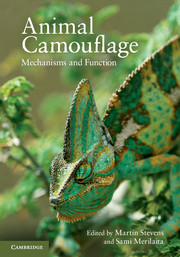Book contents
- Frontmatter
- Contents
- Contributors
- 1 Animal camouflage
- 2 Crypsis through background matching
- 3 The concealment of body parts through coincident disruptive coloration
- 4 The history, theory and evidence for a cryptic function of countershading
- 5 Camouflage-breaking mathematical operators and countershading
- 6 Nature's artistry
- 7 Camouflage behaviour and body orientation on backgrounds containing directional patterns
- 8 Camouflage and visual perception
- 9 Rapid adaptive camouflage in cephalopods
- 10 What can camouflage tell us about non-human visual perception? A case study of multiple cue use in cuttlefish (Sepia spp.)
- 11 Camouflage in marine fish
- 12 Camouflage in decorator crabs
- 13 Camouflage in colour-changing animals
- 14 The multiple disguises of spiders
- 15 Effects of animal camouflage on the evolution of live backgrounds
- 16 The functions of black-and-white coloration in mammals
- 17 Evidence for camouflage involving senses other than vision
- Index
- Plate section
- References
4 - The history, theory and evidence for a cryptic function of countershading
Published online by Cambridge University Press: 05 June 2012
- Frontmatter
- Contents
- Contributors
- 1 Animal camouflage
- 2 Crypsis through background matching
- 3 The concealment of body parts through coincident disruptive coloration
- 4 The history, theory and evidence for a cryptic function of countershading
- 5 Camouflage-breaking mathematical operators and countershading
- 6 Nature's artistry
- 7 Camouflage behaviour and body orientation on backgrounds containing directional patterns
- 8 Camouflage and visual perception
- 9 Rapid adaptive camouflage in cephalopods
- 10 What can camouflage tell us about non-human visual perception? A case study of multiple cue use in cuttlefish (Sepia spp.)
- 11 Camouflage in marine fish
- 12 Camouflage in decorator crabs
- 13 Camouflage in colour-changing animals
- 14 The multiple disguises of spiders
- 15 Effects of animal camouflage on the evolution of live backgrounds
- 16 The functions of black-and-white coloration in mammals
- 17 Evidence for camouflage involving senses other than vision
- Index
- Plate section
- References
Summary
It has been evolved alike in many unrelated groups of animals by the hunter and the hunted; in the sea and on land. It tones the canvas on which are painted the Leopard's spots, the Tiger's stripes, and the patterns of smaller Carnivora such as Serval and Ocelot, Civet, and Genet, Jackal and Hyaena. It is the dress almost universally worn by rodents, including the Vizcacha, Jerboas, Gerbils, Cavies, Agouties, Hares, and many other. It is the essential uniform adopted by Conies, Asses, Antelopes, Deer, and other groups of ungulates. It is repeated extensively among the marsupials, as seen in the coloration of the Tasmanian wolf, Opossums, Wallabies and others. It forms the background to reveal the beautiful subtle picture patterns worn by Wheatears, Warblers, Pipits, Woodcock, Bustards, and innumerable other birds. It provides a basic livery for the great majority of snakes, lizards, and amphibians. Among insects it reaches a fine state of perfection in different caterpillars and grasshoppers.
Hugh Cott (1940)In 1896 American artist and naturalist Abbott Handerson Thayer published an article in The Auk entitled ‘The law which underlies protective coloration’. In this article he observed that ‘animals are painted by nature darkest on those parts which tend to be most lighted by the sky's light, and vice versa’. As an example, Thayer described the plumage of the ruffed grouse, whose feathers are dark brown on the back and blend gradually into white on the underneath. Such a gradation in shading, Thayer hypothesised, made three-dimensional bodies appear less round and less solid by balancing and neutralising the effects of illumination by the sun. Thayer called this type of patterning obliterative shading, which today we term countershading.
- Type
- Chapter
- Information
- Animal CamouflageMechanisms and Function, pp. 53 - 72Publisher: Cambridge University PressPrint publication year: 2011
References
- 7
- Cited by



